Home | Front Page | Index | Blog | New | Contact | Site Map
Quiz Answer: Leon Viejo, Nicaragua
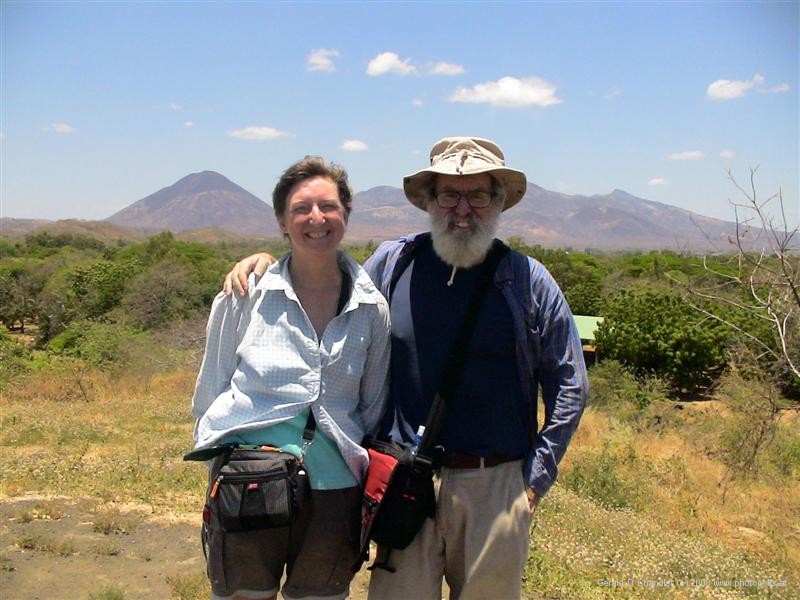
The first city of Leon was founded in 1524 about 100 km west of today's Leon. That was too close to Volcan Momotombo (1280 m, in background) which buried Leon Viejo in ashes, etc, about a century after its founding. The ruins were abandoned and then forgotten until archaeologists uncovered them starting in 1967. Today it makes a pleasant visit to the national park.
Travel
2004
| 2003
| 2002
| 2001
| 2000
Year In Review
Book Reviews
GerryGrumbling
JanJotting
Jokes
Jan's Resume
Friends' Pages
Recommended Links
Mexico 2004
Belize
Guatemala
Honduras
Nicaragua
Costa Rica
Panama
Virginia
North Carolina
South Carolina
Georgia
Florida
Alabama
Louisiana
Texas
Arizona
California
Nevada
Egypt (Jan, 2002)
Israel (Feb-Mar, 2002)
Turkey (Apr-May 2002)
Bulgaria (early June, 2002)
Romania (early June, 2002)
Ukraine (June, 2002)
Poland (July, 2002)
Prague (July, 2002)
Britain (Aug-Sep) 2002
USA (Oct-Dec) 2002
Through April, 2004
Our write-up of Prague was finally done, spurred on by a request for more information.
We cleaned up a lot of HTML and replaced lots of explict specification of font, color, etc, by the use of style sheets. This applies particularly to our Frontpages, Paris, and Israel.
Are we only human? We hope not. But we must admit that changing hotel room every few days and seeing a half dozen museums and ornate churches a week made both of us ready for a slow down. After finding that we had to rush through the last parts of Mexico and that we quit Guatemala without seeing everything we wanted, it was a relief of sorts to come to countries where we expected to be laid back and have more than enough time stamped in our passports to see all we wanted. This proved to be the case in both Honduras and and its south-eastern neighbor Nicaragua where, from Mid-March to Mid-April, we spent five weeks — exactly 35 days. Where we could we stayed extra nights and we didn't regret it so much that a museum or church was closed.

Honduras - Nicaragua Route. Overnights in Green
|
Over these five weeks we snaked about 1500 miles, through the center of Honduras and then along the Pacific coast of Nigaragua, as the map above shows. Besides museums and churches we'd also had enough of beaches and mostly skipped them. What we did do was take walks, have talks, and read and watch TV. The exception to this was, as explained below, our first few days in Honduras and our visit to Copan.
March 16 - 30: Honduras
The one, great, site not to be missed in Honduras is Copan where wonderful Mayan stelae and ruins are located. We crossed the Guatemalan border and went straight to Copan Ruinas, the misnamed tourist town one kilometer from the ruins. Our 15 kilometer drive was a pleasure in itself, since the countryside is beautiful. We'd learn that over and over in the next two weeks.
There are a lot of beaches on the Caribbean coast but we were put off them by LP's report of biting flies and expense of getting to the various islands. The one beach possibility that we seriously considered was Omoa, in the west, near Guatemala. In fact, when we were in Rio Dulce we thought of taking a boat there and probably would have if we hadn't been the owners of a car. But we skipped it because we thought we'd had enough beach lately and its hippy-atmosphere didn't appeal either.
Instead we went to mountain and hill country. Our first stop after Copan Ruinas was Gracias, an old, poor colonial town located within a long hike of the highest point in Honduras, 2827 m Montana de Celaque. We regret that we didn't spend an extra couple of days in the area and hike part of it. We did get good views. Then we went on again through pleasant country and stayed four days at Lago Yojoa, the largest lake in Honduras. Everybody said it wasn't rainy season, but it felt like it to us. We hadn't seen so much rain since we left England more than a year earlier.

Central Stelae Courtyard, Copan Mayan Ruins |
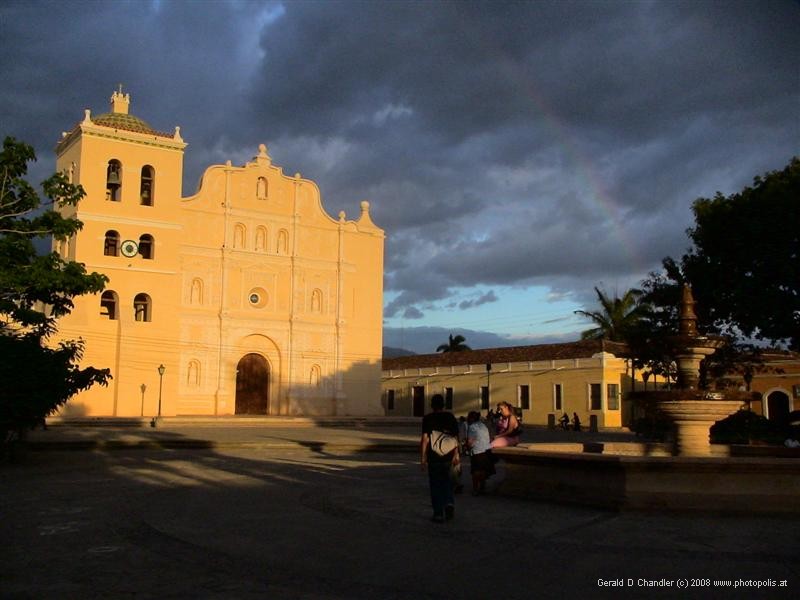
Cathedral, Comayagua |
Then it was back to town, two capitals in a row: Comayagua, the capital of Honduras from about 1560 until 1880, and Tegucigalpa, capital from 1880 onwards. Comayagua is nice but does not stand out: it has four old churches of note and a few other colonial buildings; surprising little for 300 years as capital; perhaps that shows that Honduras had a small population and was poor. We spent a few relaxed days there, meeting a peace corp volunteer and talking politics and the owner of the local laundry talking about economic development — or the lack there of.
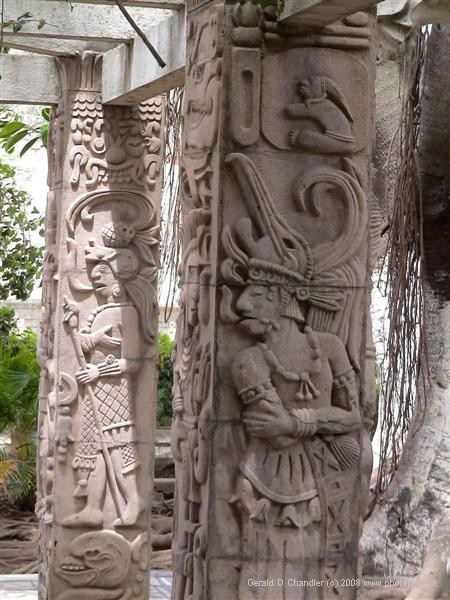
Mayan reproductions in Parque La Concordia |
Tegucigalpa has grown in the hundred plus years since becoming capital to a metropolitan area population of over a million. It sits among more interesting mountains than Comayagua and has the usual mixture of ugly and interesting of any large city. We enjoyed a couple of museums, a superb park with reproductions of Mayan ruins, and our more upscale than usual hotel, the MacArthur, with its swimming pool and holy-roller sounds coming in many hours of the day from a nearby Protestant church.
We ended our stay in Honduras by turning a four hour trip to the border into a day and a half trip. We did this by spending a full morning leaving Tegucigalpa, stopping on its outskirts to see the Basilica at Suyapa. Then we drove to Paraiso, near the border and spent the late afternoon getting our muffler repaired and walking around what was a quaint place for us. The next morning we were off for the last few miles to Nicaragua.
March 30 - April 12: Nicaragua
Our sputtering museum-culture-everything engine slowed even more in Nicaragua, where Culture and People are both relatively scarce.
We dubbed the once-land of the Sandinistas the place of cold showers. From Mexico south through Belize, Guatemala, and Honduras we had never had to do without the luxury of a hot shower. But suddenly we were told that the water straight-from-the-tap was hot enough. It was, as we reluctantly learned, because Nicaragua was also the sweatiest of the places we had been and we didn't need more heat in the shower. Unfortunately there are few highlands in Nicaragua (as there are in Guatemala and Honduras) and the rest, the lowlands, the populated part, comes without benefit of cooling mountain breezes or low-humidity desert climates. To top it off, having air conditioning can double the price of a room and we often skipped that.

Road leaving Ocotal |
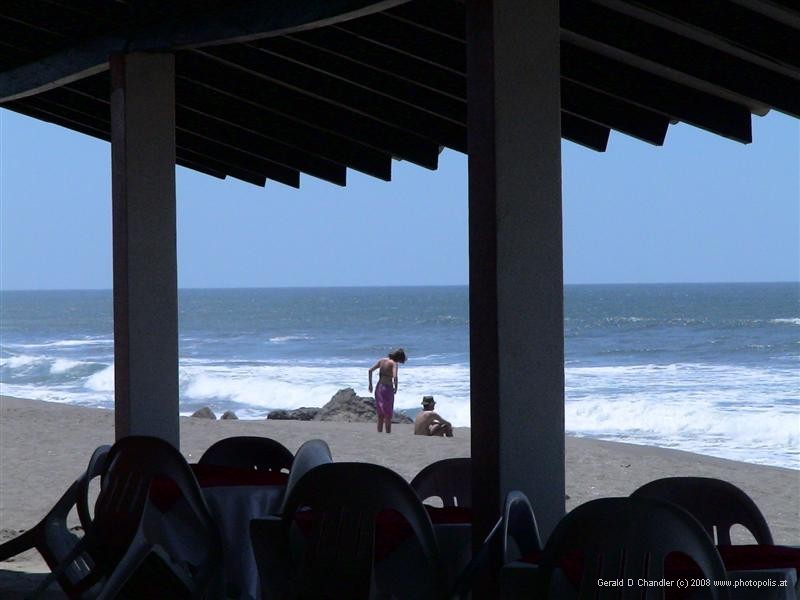
Poneloya Beach |
In the north, we spent a night near the Honduran border in the small town of Ocotal before driving down towards the coast where we spent two nights at Poneloya Beach — one at the a dive and another at the lovely Supaya Beach Resort. Our foray to the beach was brief because the weekend and Holy Week crowds invaded every beach resort and all rooms were reserved.
At Poneloya we were only half an hour drive from the former capital of Leon, a pleasant colonial city that one day, perhaps, might offer the kind of tourist attractions proffered by Antigua Guatemala. Now it is a mixture of slum, potential, and actual attractiveness, layered over with Sandinista propaganda. We drove over and spent a few days. Then we made a brief visit to Leon Viejo, the site of the original city of Leon founded by the Spaniards in the 16th century where we got a nice history and Spanish lesson and a close up view of Volcan Momotombo and the shore of Lake Managua.
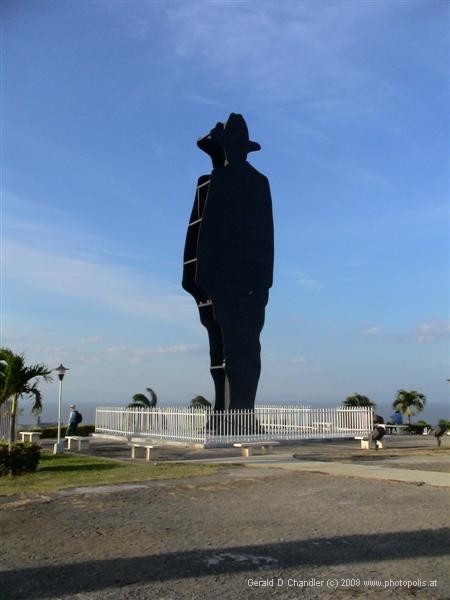
"Outline" Statue of Augusto Sandino,
|
In Managua we stayed at Franz Orschel's "gemütlich" bed and breakfast and thereby found asylum from the tourist rush of Semana Santa. One day we walked all around the central part of the city, including going up on the hill and communing with the 2-D statue of August Cesar Sandino that is visible from many parts of the city. With Managua as a base we made two exursions, one to Granada, another former capital, and the other to the area around the Masaya Volcano to browse handicraft stores and admire the views of Lake Masaya and Lake Nicaragua.
After a very comfortable week, we threw ourselves into the fire by going to La Boquita, a very small beach area with poor accommodations. Then we continued on to Ometepe a rural island in enormous Lake Nicaragua, made of two volcanos whose slopes have joined. Things must have changed a lot in the last few years as life there is not much different than many other remote parts of Nicaragua: lots of people have electricity and satellite TV dishes are to be seen. We walked and hiked and read. Then we took the ferry to the mainland and made our final journey in Nicaragua, a short drive to the Costa Rican border.